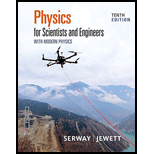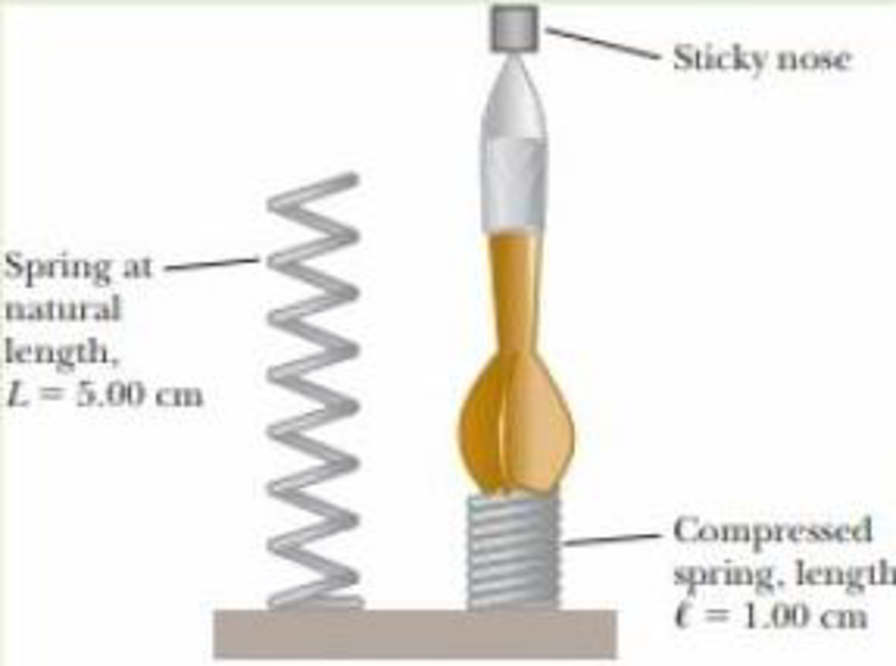
Concept explainers
You are lying in your bedroom, resting after doing your physics homework. As you stare at your ceiling, you come up with the idea for a new game. You grab a dart with a sticky nose and a mass of 19.0 g. You also grab a spring that has been lying on your desk from some previous project. You paint a target pattern on your ceiling. Your new game is to place the spring vertically on the floor, place the sticky-nose dart facing upward on the spring, and push the spring downward until the coils all press together, as on the right in Figure P7.26. You will then release the spring, firing the dart up toward the target on your ceiling, where its sticky nose will make it hang from the ceiling. The spring has an uncompressed end-to-end length of 5.00 cm, as shown on the left in Figure P7.26, and can be compressed to an end-to-end length of 1.00 cm when the coils are all pressed together. Before trying the game, you hold the upper end of the spring in one hand and hang a bundle of ten identical darts from the lower end of the spring. The spring extends by 1.00 cm due to the weight of the darts. You are so excited about the new game that, before doing a test of the game, you run out to gather your friends to show them. When your friends are in your room watching and you show them the first firing of your new game, why are you embarrassed?
Figure P7.26

Trending nowThis is a popular solution!

Chapter 7 Solutions
Physics for Scientists and Engineers with Modern Physics
- In general it is best to conceptualize vectors as arrows in space, and then to make calculations with them using their components. (You must first specify a coordinate system in order to find the components of each arrow.) This problem gives you some practice with the components. Let vectors A = (1,0, −3), B = (-2, 5, 1), and C = (3,1,1). Calculate the following, and express your answers as ordered triplets of values separated by commas.arrow_forwardOnly Part C.) is necessaryarrow_forwardOnly Part B.) is necessaryarrow_forward
- A (3.60 m) 30.0°- 70.0° x B (2.40 m)arrow_forwardIn general it is best to conceptualize vectors as arrows in space, and then to make calculations with them using their components. (You must first specify a coordinate system in order to find the components of each arrow.) This problem gives you some practice with the components. Let vectors A = (1,0, -3), B = (-2, 5, 1), and C = (3,1,1). Calculate the following, and express your answers as ordered triplets of values separated by commas.arrow_forwardfine the magnitude of the vector product express in sq meters what direction is the vector product in -z or +zarrow_forward
- 4) Three point charges of magnitude Q1 = +2.0 μC, Q2 = +3.0 μС, Q3 = = +4.0 μС are located at the corners of a triangle as shown in the figure below. Assume d = 20 cm. (a) Find the resultant force vector acting on Q3. (b) Find the magnitude and direction of the force. d Q3 60° d Q1 60° 60° Q2 darrow_forwardThree point charges of magnitudes Q₁ = +6.0 μС, Q₂ = −7.0 μС, Qз = −13.0 μC are placed on the x-axis at x = 0 cm, x = 40 cm, and x = 120 cm, respectively. What is the force on the Q3 due to the other two charges?arrow_forwardTwo point charges of +30.0 μС and -9.00 μC are separated by a distance of 20.0 cm. What is the intensity of electric field E midway between these two charges?arrow_forward
- Two point charges of +7.00 μС and +10.0 μС are placed inside a cube of edge length 0.100 m. What is the net electric flux due to these charges?arrow_forwardA conducting hollow sphere has a charge density of σ = 12.2 μC/m². If the sphere has a radius of 25 cm, what net charge is on the sphere?arrow_forward9) Consider an electric field right Ĕ = 21+3ĵ. What is the magnitude of the flux of this field through a 4.0 m² square surface whose corners are located at (x,y,z) = (0, 2, 1), (2, 2, 1), (2, 2, −1), (0, 2, −1)? Ꮓ ту x (0,2,1) Surface 2 Surface (2,2,1) y Ē (0,2,-1) (2,2,-1) 2 xarrow_forward
 Physics for Scientists and Engineers: Foundations...PhysicsISBN:9781133939146Author:Katz, Debora M.Publisher:Cengage Learning
Physics for Scientists and Engineers: Foundations...PhysicsISBN:9781133939146Author:Katz, Debora M.Publisher:Cengage Learning Principles of Physics: A Calculus-Based TextPhysicsISBN:9781133104261Author:Raymond A. Serway, John W. JewettPublisher:Cengage Learning
Principles of Physics: A Calculus-Based TextPhysicsISBN:9781133104261Author:Raymond A. Serway, John W. JewettPublisher:Cengage Learning Physics for Scientists and Engineers with Modern ...PhysicsISBN:9781337553292Author:Raymond A. Serway, John W. JewettPublisher:Cengage Learning
Physics for Scientists and Engineers with Modern ...PhysicsISBN:9781337553292Author:Raymond A. Serway, John W. JewettPublisher:Cengage Learning Physics for Scientists and Engineers, Technology ...PhysicsISBN:9781305116399Author:Raymond A. Serway, John W. JewettPublisher:Cengage Learning
Physics for Scientists and Engineers, Technology ...PhysicsISBN:9781305116399Author:Raymond A. Serway, John W. JewettPublisher:Cengage Learning College PhysicsPhysicsISBN:9781285737027Author:Raymond A. Serway, Chris VuillePublisher:Cengage Learning
College PhysicsPhysicsISBN:9781285737027Author:Raymond A. Serway, Chris VuillePublisher:Cengage Learning Physics for Scientists and EngineersPhysicsISBN:9781337553278Author:Raymond A. Serway, John W. JewettPublisher:Cengage Learning
Physics for Scientists and EngineersPhysicsISBN:9781337553278Author:Raymond A. Serway, John W. JewettPublisher:Cengage Learning





